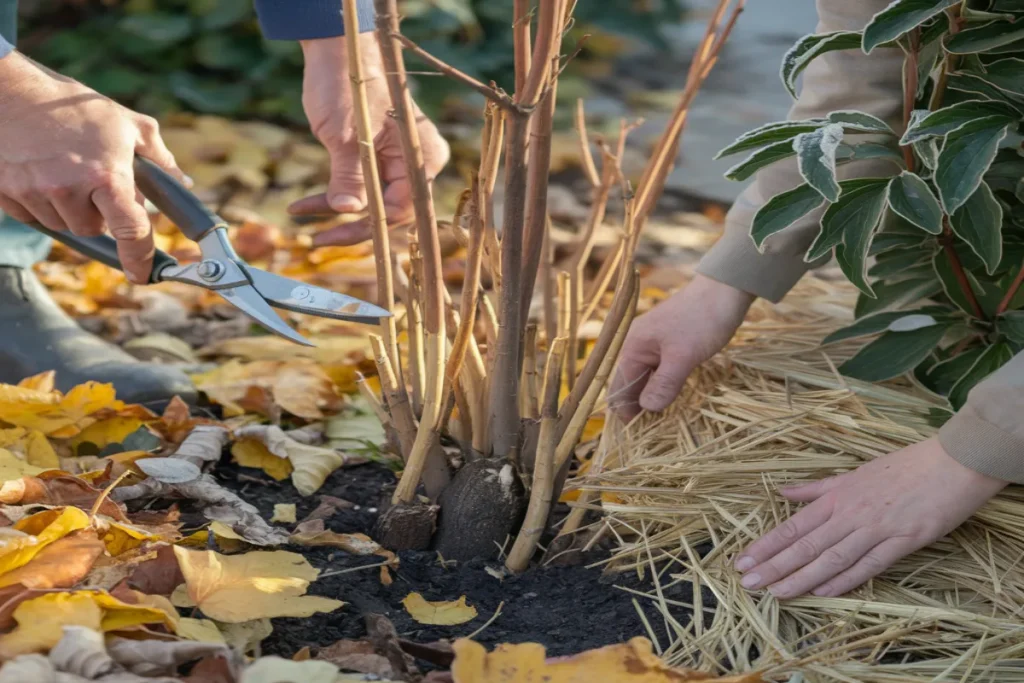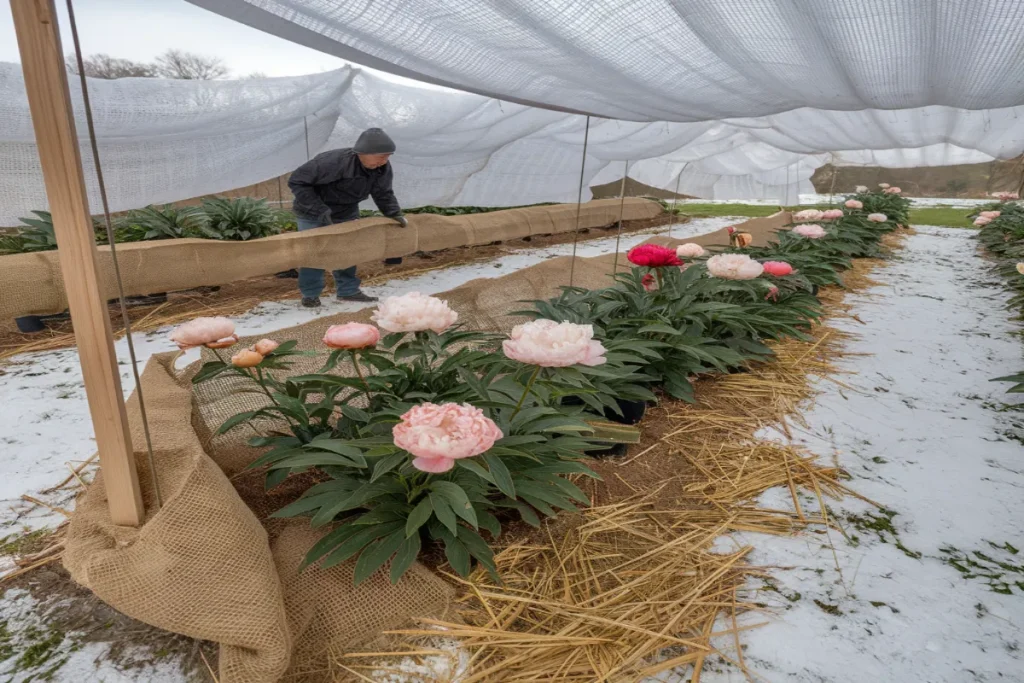Imagine Laura Matthews in her Wisconsin garden, watching peony stems turn crimson as autumn comes. Her grandmother’s peonies have been there for years, teaching her about caring for them. It’s not just gardening; it’s keeping a family tradition alive.
Peony winter care is needed for them to stay beautiful. They can bloom for 100 years if protected well. Whether you’re caring for a peony bush or preparing roots for cold, knowing their needs is key.
Herbaceous peonies die back in late fall, hiding underground to save energy. Tree peonies, growing up to 6 feet tall, stay visible in winter. Each type needs special care to thrive.
This guide will show you how to protect your peonies. You’ll learn about pruning and mulching to keep them looking great all winter. Get ready to make your peonies bloom again when spring comes.
Table of Contents
Understanding Peony Varieties and Hardiness Zones
Peonies are amazing garden plants known for their beautiful flowers and toughness. If you want to care for peonies in fall and winter, it’s important to know about the different types and where they grow best.
Common Peony Types
There are three main types of peonies, each with its own way of surviving winter:
- Herbaceous Peonies: The most common type, they die back to the ground each winter
- Tree Peonies: These are woody shrubs that keep their shape during cold months
- Intersectional (Itoh) Peonies: A mix of herbaceous and tree peonies, combining the best of both
Ideal Hardiness Zones for Peonies
To care for peonies in winter, knowing the hardiness zones is key. These plants do best in certain temperatures, so picking the right zone is essential for their success.
| Peony Type | Ideal Hardiness Zones | Winter Characteristics |
|---|---|---|
| Herbaceous Peonies | Zones 3-7 | Completely dormant, underground |
| Tree Peonies | Zones 4-8 | Woody structure remains visible |
| Itoh Peonies | Zones 4-9 | Moderate winter die-back |
When getting ready for fall and winter peony care, pick varieties that fit your climate. Peonies need cold to bloom in spring, making them great for areas with clear seasons.
*”Choose your peony variety carefully, and it will reward you with decades of breathtaking blooms.”*
Knowing about these varieties helps gardeners protect their plants better in winter. This leads to healthy growth and beautiful blooms in spring.
Preparing Peonies for Winter
Caring for peonies in the fall is key to their survival. You need to protect them from cold weather. This ensures they grow well when spring comes.
Pruning Techniques for Peonies
Proper pruning is vital for peony care in winter. When frost hits, it’s time to get your peonies ready for sleep. Here are the main pruning steps:
- Cut stems down to 2-3 inches above the soil level
- Remove all dead leaves and foliage completely
- Use clean, sharp pruning shears to prevent disease transmission
- Dispose of clippings away from the garden to prevent pest spread
Cleaning and Mulching Strategies
Cleaning up is important for peony winter care. Good sanitation stops disease and helps growth in spring.
| Winter Care Step | Recommended Action |
|---|---|
| Foliage Removal | Cut back to 1 inch above soil level after first frost |
| Mulch Application | Apply 2-3 inches of organic mulch in areas with severe winters |
| Soil Protection | Ensure mulch does not cover peony eyes deeper than 2 inches |
Pro Tip: Herbaceous peonies need 6-8 weeks of cool weather for best spring blooms.
Wintering peonies well depends on good preparation. By pruning and cleaning right, your peonies will make it through winter. They’ll bloom beautifully in spring.

Mulching and Insulation Tips
Protecting peonies in winter needs careful mulching. Knowing how to prepare peonies for winter can greatly help them survive and bloom well in spring.
Mulching is key to keeping peonies healthy in the cold. The quality of winter prep and insulation greatly affects what peonies look like in winter.
Best Mulch Materials for Peonies
Choosing the right mulch is vital for peony winter survival. Here are the best mulching options:
- Organic bark chips
- Straw
- Leaf mold
- Compost
How to Apply Mulch Effectively
Applying mulch right is key to protect peony roots from cold. Follow these important tips:
- Apply 2 inches of mulch around the base
- Avoid covering the plant’s crown
- Leave space around the stem to prevent rot
| Mulch Type | Benefits | Recommended Depth |
|---|---|---|
| Bark Mulch | Excellent insulation | 2 inches |
| Straw | Lightweight protection | 1-2 inches |
| Compost | Adds nutrients | 1.5 inches |
*”Proper winter protection transforms delicate peonies into resilient garden treasures.”*
Understanding what peonies look like in winter starts with these strategic mulching techniques. Good insulation can make a big difference in their health.
Watering Practices Before Winter
Getting peonies ready for winter means paying close attention to how you water them. It’s important to keep the roots safe from too much water. This helps prevent damage from too much moisture.
Importance of Proper Hydration
It’s key to water peonies right when you’re overwintering them in pots or in the ground. They need a watering plan that meets their moisture needs without drowning them during winter.
- Water deeply but infrequently in late fall
- Reduce watering as temperatures drop
- Ensure soil remains slightly moist but not waterlogged
Signs of Overwatering
It’s important to know when you’re watering peonies too much. Look out for these signs:
| Symptom | Potential Damage |
|---|---|
| Soggy soil | Root rot risk |
| Yellowing leaves | Nutrient absorption issues |
| Standing water | Fungal disease risk |
*”Moisture management is the key to successful peony winter survival”* – Gardening Experts
Potted peonies need extra care in winter. They need more checks on the soil moisture than those planted in the ground. Keep the soil consistently a bit damp but not too wet.
For winter care, check the soil moisture every week. Water less as it gets colder. Make sure the soil drains well to avoid root problems during sleep.
Pest and Disease Management
Winter poses unique challenges for peony health. To keep your peonies safe, you need to manage pests and diseases carefully. This ensures they make it through the cold season and bloom beautifully in spring.
Peonies face many health issues in winter. You might wonder if peonies die in the cold. But with the right care, they can beat the winter blues.
Common Winter Pests
Several pests can harm peonies in winter:
- Scale insects: Can cause leaf yellowing
- Thrips: Can damage flower quality
- Foliar nematodes: Risk of significant plant decline
Preventative Treatments
To manage winter pests, you need a solid plan:
- Clear plant debris around peony bases
- Apply the right fungicides
- Make sure there’s good air circulation
| Disease | Infection Rate | Potential Impact |
|---|---|---|
| Botrytis Blight | 50-90% | Severe shoot rot |
| Powdery Mildew | 5-10% | Cosmetic damage |
| Southern Blight | 40% | Potential plant death |
Proactive care is key to maintaining peony health through winter months. Regular checks and quick action can greatly lower the risk of damage from pests and diseases.
Vigilance and proper winter preparation are your best defense against peony health threats.
Protecting Peonies from Severe Weather

Winter brings special challenges for peony care. Gardeners need to know how to protect their peony bushes from harsh weather. This could damage these beautiful plants.
Peonies are tough but need protection in cold months. It’s important to shield them without blocking needed cold for spring blooms.
Creating Effective Windbreaks
Windbreaks are key for peony winter protection. Here are some tips:
- Plant peonies near solid fences or sturdy shrubs
- Use burlap screens to deflect strong winds
- Position plants in areas with natural landscape protection
Using Row Covers for Extra Protection
Row covers add extra defense against winter. Use them when temperatures drop below 30 degrees Fahrenheit. Here’s how:
- Select breathable row cover materials
- Apply covers during mid-day to retain ground heat
- Remove covers periodically to prevent moisture buildup
| Winter Protection Method | Effectiveness | Recommended Usage |
|---|---|---|
| Burlap Windbreaks | High | Areas with consistent strong winds |
| Row Covers | Medium-High | Temporary frost protection |
| Mulching | High | Regions with severe winters |
Expert Tip: Herbaceous peonies need 32-40 degrees F for several weeks to bloom. Don’t over-protect and interrupt this natural process.
“Protecting peonies is about understanding their natural resilience while providing strategic winter care.” – Garden Experts
When to Remove Winter Protection
Getting your peonies ready for spring needs careful planning. You must know when to stop protecting them from winter. It’s a delicate time, moving from cold protection to new growth.
Recognizing the Right Time to Uncover Peonies
Knowing when to take off the covers is key. Look for these signs that winter is over:
- Consistent daytime temperatures above 40°F
- No predicted frost in local weather forecasts
- Soil beginning to warm and soften
- Emerging green shoots from the ground
Gradual Unveiling Techniques
When revealing your peonies, do it slowly. Gradual exposure is key to preventing shock to your plants. Start by removing the top layer of mulch, letting the plant adjust slowly.
“Patience in spring unveiling can make the difference between thriving and struggling peonies.” – Garden Experts
Timing varies by region. Gardeners in USDA Hardiness Zones 3-5 should wait longer than those in Zones 6-8. Always watch the weather and be ready to protect your plants if it gets cold again.
Protective Removal Checklist
- Check local weather forecasts
- Inspect plant for early growth signs
- Remove mulch in stages
- Keep protective materials nearby for cold nights
- Gently clean around emerging shoots
By following these steps, gardeners can help their peonies grow well from winter to spring. This sets them up for a beautiful blooming season.
Frequently Asked Questions
Should peonies be cut back for winter?
Yes! Peonies should be cut back in late fall (October or November) after the leaves turn yellow or brown. This helps prevent disease and encourages healthy growth next spring.
How do I winterize my peony?
Cut back the stems to about 1-2 inches above the ground after the first frost.
Remove dead leaves and stems to prevent pests and fungal diseases.
Mulch lightly (only in very cold climates) with straw or pine needles to protect roots.
Avoid heavy mulch—peonies like cold winters and don’t need much insulation.
Should I cut my peonies down to the ground?
Yes, but leave about an inch or two of the stems above the soil. This prevents rot and keeps the plant healthy for the next season.
Do you have to dig up peonies for winter?
Nope! Peonies are hardy perennials that survive cold winters just fine. The only time to dig them up is if you’re dividing or moving them, which should be done in early fall.
What happens if you don’t deadhead peonies?
If you don’t deadhead, the plant will put energy into producing seeds instead of strengthening the roots. While it won’t harm the plant, deadheading keeps it looking tidy and encourages better blooms next year.
How do I save peonies for next year?
Cut them back in fall to prevent disease.
Feed them with compost or a balanced fertilizer in early spring.
Keep them in full sun and well-draining soil—peonies hate wet feet!
Don’t move them too often—they take time to settle and bloom best when left alone.

